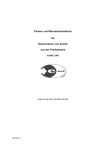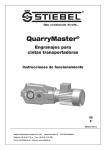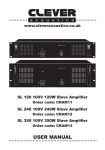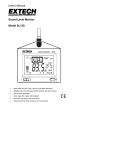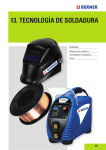Download SmartLine SL 120-12 Inverter / Voltage transformer User manual
Transcript
SmartLine SL 120-12 Inverter / Voltage transformer Power Inverter User manual User Manual Please rear this User Manual before taking the Voltage Transformer into operation! SL120.02_GB Contents Overall view...................................................................................... 3 Important safety instructions ............................................................ Area of operation ......................................................................... Cable ........................................................................................... Care and maintenance................................................................. Children ...................................................................................... Intended use .............................................................................. Technical specifications ............................................................. 4 4 4 5 5 5 6 Introduction ..................................................................................... Important instruction for use........................................................ 7 7 Connecting the inverter .................................................................... Connecting to a vehicle socket ................................................... Disconnecting ............................................................................. Replacing the fuse ....................................................................... 8 8 .8 8 Appendix............................................................................................ Troubleshooting ........................................................................... Compliance ................................................................................. Disposal of old and defective devices .......................................... 9 9 10 10 Additional current information can be found on the Internet page: www.e-ast.de and www.heicko.de For service and guarantee please contact your dealer. We would also like to help you. Write to us at [email protected]. heicko Vertriebs GmbH, 51545 Waldbröl © heicko 2011 – Reproduction and reprinting only with our permission SL120.02_D Overall view 3 6 4 2 5 1 1 2 3 4 5 6 Connector for cigarette lighter with indicator light (green) Euro socket Power switch Indicator "Fault" (red) Power light (green), "Ready" USB - port, 5 V 500 mA (hidden in the image) Range of use The Inverter SL 120-12 can be used to provide 230 V AC for laptops, radios, MP3 - players, cell phone charger etc. by means of 12 V DC (e.g. car battery). Important: the devices connected should not have a continuous power consumption of more than 120 W. 3 Important instructions and area of operation Before the initial use of the device please thoroughly read the following instructions and comply with all warnings, even if you are accustomed to being around electronic devices. Keep this handbook safe for future reference. Should you sell the device or pass on to someone else, these instructions should also be passed along. In the event of a (thunder) storm with the possibility of lightning the device must be disconnected from the vehicle onboard power supply system. Note especially the instructions on the area of operation CAUTION: Instructions on disconnecting: The device uses power when connected to the vehicle on-board power via the on-board connector. To completely remove the device from the on-board power the connector has to be completely removed from the socket. The device should be installed so that access to the on-board connector can be had at any time so that the device can be disconnected immediately in the case of emergency. To eliminate the risk of fire the power connector of a connected consumer should always be removed from the power socket if the device is not to be used for a long period of time. Place the device on a stable level surface and do not place any heavy objects on the device. Make sure that there is sufficient ventilation at all times. Place the device so that none of the ventilation openings are covered and make sure that there is a 10 cm clearance on all sides; no sources of heat can affect the device (e.g. heating); no direct sunlight or strong artificial light can fall on the device; contact with a water spray or drops and aggressive liquids is avoided at all times and that the device is not operated in the vicinity of water. On no accounts should the device be submerged. Do not place any objects filled with liquids on or near the device; do not place the device near any magnetic fields (e.g. loudspeakers); do not place any open flames (e.g. candles) on or near the device; do not poke any objects through the socket or any other opening on the device; do not subject the device to any extreme temperature fluctuations as this can cause moisture to condense and lead to short circuits; do not allow the device to be subjected to any excessive shocks and vibrations; do not allow children to have access to the device. The device is not a toy. Cable Always grasp cables on the plug and never pull on the cable itself. Never grasp the connection cable with wet hands as this can cause a short circuit or an electric shock. Do not place the device itself, pieces of furniture or other heavy items on the cable. Make sure that the cable is not kinked especially at the plug and the connection sockets. Never tie a knot in the cable and never fasten it to another cable. All cables should be laid so that nobody can step on them or be hindered by them. If the connection cable is to be placed in a vehicle make sure that the cable is protected from sharp metal panels. Use cable ducts or conduits. A damaged connection cable can cause a fire or an electric shock. 4 Check the connection cable regularly. Do not use any adapter or extension cable that is not in compliance with the current safety standards and do not make any modifications to the connection cables. Care and maintenance It is necessary to service the device if it is damaged, e.g. if the connection cable, connector or the casing is damaged, liquid or objects get inside the device; if it is subjected to rain or moisture, or if it is no longer in perfect working order or has fallen down. If smoke develops, unusual noises or odours are noticed switch the device off immediately and separate it from the on-board power. If anything like this happens the device should no longer be used before it has been checked by an expert. Only allow maintenance operations to be carried out by a qualified expert. Never open the casing of the device. If the casing is open there is a lethal danger of electric shock. Cleanse the device with a clean dry cloth and never use aggressive liquids. Never try to open the casing of the device. This will invalidate your guarantee. Children Electrical devices should not fall into the hands of children! Never allow children to use electrical devices without supervision. Children often do not notice any possible danger. Small parts can be life threatening if swallowed. Also keep the packaging foil away from children. There is the danger of suffocation. Intended use This Inverter is designed to convert 12 V DC to 230 V AC used by small electrical consumers with a maximum of 120 W consumption. It should only be used for private purposes and not for commercial or industrial purposes. As a standard device it is not intended for medical, lifesaving or life-preserving uses. Only electrical consumers with a protection class II may be connected and used with the device. It should not be used in tropical climates. Only connection cables and external devices should be used that correspond with the technical safety levels of this device with respect to Electromagnetic Interference and shielding quality. This device is compliant with all the relevant CE directives and standards. Any modification performed on the device that is not agreed to by the manufacturer may cause the device to no longer comply with the norms. If this device is not used in the Federal Republic of Germany the relevant laws and standards of the country in which it is used have to be observed. Any other use is considered to be improper use and is therefore forbidden. Technical specifications SL 120-12 Input voltage 12 V (DC) Output voltage 230 V (AC), 50 Hz Output voltage USB 5 V (DC), 500 mA 5 Continuous output power 120 W Peak power output 240 W (0.1 s) Quiescent Current approx. 0.4A Undervoltage warning 11 V (DC) Undervoltage shutdown 10.5 V (DC) Overvoltage protection 15.0 V (DC) Fuses 1 glass fuse in the plug of the connecting cable: 15 A (6.3 x 32 mm) Protection class Minimum capacity of the II 20 Ah Auto battery Weight 0.26 kg Dimensions (L x B x H) 135 x 74 x 26 mm Introduction Many thanks for choosing this high quality product form our "e-ast model range". You can connect any device to this inverter that has a maximum power consumption of 120 W. This gives you the possibility to connect any mobile device in your vehicle e.g. notebooks, audio and video devices or chargers. The SL 120-12 has a cable with a plug for the cigarette lighter that allows you to connect the device to the car on-board socket (12 V). Important instructions for use 6 Observe the information for the continuous output power and the peak performance. Devices that have a power consumption of more than 120 W are not allowed to be used with this inverter. The higher peak power output is only for supplying the momentary inrush current when a device is switched-on. If a device is connected to the inverter for the first time be aware of any temperature development and any strange noises. The inverter supplies a sinusoidal square wave voltage to the power socket. Some devices cannot recognise this supply. In such cases humming noises may be heard and/or an increase in temperature. In such a case the consumer is not compatible with the inverter and should not be used. In some cases when complicated loads are connected there can be undesired effects. For example the use of energy saving lamps is to some extent restricted. Be aware of the audible warning and the indicator lights (4). If there is an audible warning or the indicator light is illuminated the car battery is almost discharged. Switch-off the connected consumers and separate from the on-board power. Only use the inverter after the car battery has been recharged. With complicated loads damage to the connected device cannot be excluded. If using high-value or sensitive devices check with the manufacturer before connecting to an inverter with modified sine wave voltage. The modified sine wave on the power output cannot be detected with standard multimeters. The indicated voltage is considerably distorted. The voltage with the modified sine wave can only be determined with an RMS-enabled volt or multimeter. Connecting the inverter to a 12 V car on-board connector Remember that the consumers that are to be connected with this type of connection should not exceed 150 W. An on-board connector is limited to 150 W in almost all vehicles. 1. 2. 3. 4. 5. 6. Make sure that the car on-board connector supplies 12 V – connecting to 24 V will destroy the inverter. Make sure that no consumers are connected to the Euro power socket (2) of the inverter before connecting to the on-board connector. Take the connector (1) and connect to the on-board power via a suitable car on-board connector. Connect the consumer to the Euro socket (2). Switch the inverter on with the power switch (3). Keep the switch pressed for at least 3 seconds. Switch-on the consumer. 7 Note: If the voltage supply to the inverter is interrupted during operation it automatically switches off. This means that once the voltage is reapplied the inverter needs to be switched-on again according to point 5. Disconnecting 1. 2. Switch-off the consumer and remove the power plug from the power socket (2) of the inverter. Switch-off the inverter by pressing the power switch (3) for approx. 3 seconds. 3. Loosen the connection to the on-board power. Pull the plug out of the on-board socket. Replacing the fuse To replace the glass fuse in the connector (1) loosen the cap on the front side (see image below). Use a suitable tool if necessary. Turn the cap anti-clockwise until it is completely released and remove the fuse from the connector casing. back into the plug casing. If the contact pin falls out of the cap, push this back into the cap from the rear before reclosing the plug. Replace the defective fuse with a new one and screw the cap Annex Troubleshooting No output voltage Check that the on-board connector is correctly seated in the on-board socket and the green indicator light on the plug is illuminated. Check the voltage supply to the on-board socket. Check that the inverter is switched-on and the green power light (5) is illuminated. If that device has been in operation for a while with a high load the thermal fuse may be active. If the casing of the inverter is hot allow the device to cool down before reconnecting. Check the glass fuse in the connection cable plug. If defective replace the fuse with a new one that has a value of 20 A (refer to previous page). Audible alarm (announces one of the following conditions) Over temperature: 8 The over temperature protection is active and the device has switched itself off (error indicator (4) is illuminated). To reactivate the device first switch-off at the power switch (3) and allow it to cool. Undervoltage The voltage of the car battery is too low. Recharge the car battery. With an undervoltage the error indicator (4) first illuminates as soon as the device has switched itself off completely. The error indicator (4) illuminates There is a voltage of more than 15 V DC at the input (e.g. Truck on-board voltage). Remove the inverter immediately from the supply voltage. Declaration of Conformity This device has been tested for compliance with the essential requirements and other relevant provisions of the EMC Directive 2004/108/EC and the Low Voltage Directive 2006/95/EC and approved. Disposal of old and defective devices This device should not be dispose of with the household waste. If this symbol with a crossed out waste bin is on a product, it is subjected to the European Directive 2002/96/EC. All electrical and electronic appliances have to be separated from the household waste and dispose of at the designated municipal locations. Proper disposal of old or damaged devices prevents environmental damage and danger to personal health and you also contribute to a high level of recycling and recovery. Additional information on disposal of old devices can be obtained from the municipality, the household waste disposal service or in the shop where the product was purchased. 9









